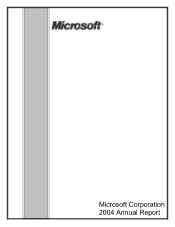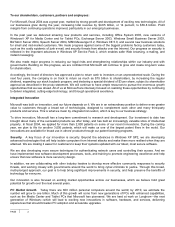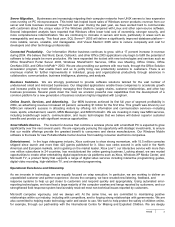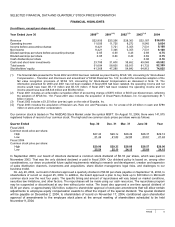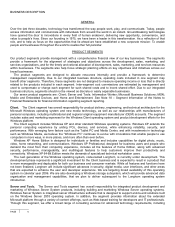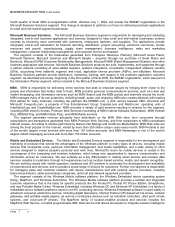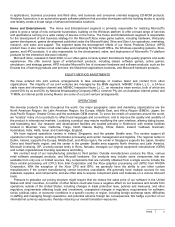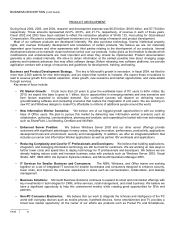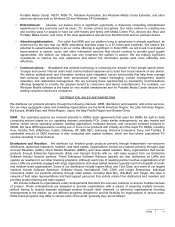Microsoft 2004 Annual Report Download - page 10
Download and view the complete annual report
Please find page 10 of the 2004 Microsoft annual report below. You can navigate through the pages in the report by either clicking on the pages listed below, or by using the keyword search tool below to find specific information within the annual report.
BUSINESS DESCRIPTION (CONTINUED)
PAGE 10
PRODUCT DEVELOPMENT
During fiscal 2002, 2003, and 2004, research and development expense was $6.30 billion, $6.60 billion, and $7.78 billion
respectively. Those amounts represented 22.2%, 20.5%, and 21.1%, respectively, of revenue in each of those years.
Fiscal 2002 and 2003 have been restated to reflect the retroactive adoption of SFAS 123, Accounting for Stock-Based
Compensation. We plan to continue significant investment on a broad range of research and product development.
Most of our software products are developed internally. We also purchase technology, license intellectual property
rights, and oversee third-party development and localization of certain products. We believe we are not materially
dependent upon licenses and other agreements with third parties relating to the development of our products. Internal
development allows us to maintain closer technical control over our products. It also gives us the freedom to decide which
modifications and enhancements are most important and when they should be implemented. Product documentation
generally is also created internally. We strive to obtain information at the earliest possible time about changing usage
patterns and hardware advances that may affect software design. Before releasing new software platforms, we provide
application vendors with a range of resources and guidelines for development, training, and testing.
Business and Product Development Strategy. The key to Microsoft’s growth is innovation. In fiscal 2004, we filed for
more than 2,000 patents for new technologies, and we expect that number to increase. We expect these innovations to
lead to revenue growth from market expansion, share growth, new scenarios and market opportunities, and value-added
through services.
Key areas of focus include:
• PC Market Growth: It took more than 20 years to grow the worldwide base of PC users to 600+ million. By
2010, we expect this base to grow to 1 billion, due to opportunities in emerging markets and new scenarios and
form factors expected to stimulate demand. Our continued success will depend on delivering secure,
groundbreaking software and compelling scenarios that capture the imagination of end users. We are working on
new PC and Windows designs to make PCs affordable to millions of additional people around the world.
• New Information Worker Scenarios: We believe one of our biggest growth opportunities is with our existing
base of Office users. We plan to pursue this market by delivering new information worker scenarios such as
collaboration, authoring, communications, planning and analysis, and expanding the toolset with new technologies
such as SharePoint, Live Meeting, OneNote and InfoPath.
• Enhanced Server Position: We believe Windows Server 2003 and our other server offerings provide
customers with significant advantages in many areas, including innovation, performance, productivity, applications
development tools and environment, security and manageability. In addition, we offer an integrated platform that
includes our server and Information Worker applications as well as partner ISV workloads and applications.
• Reducing Complexity and Cost for IT Professionals and Developers: We believe that building applications,
integration, and managing information technology are still too hard for customers. We are working on new ways to
further lower costs and speed time to deploy technology for IT professionals and developers. We believe we are
already helping reduce costs and increase business value with products such as Windows Server 2003, Visual
Studio .NET, SMS 2003, the Dynamic Systems Initiative, and Microsoft Operations Manager 2005.
• IT Services for Smaller Business and Consumers: The MSN, Windows, and Office teams are working
together on a set of integrated IT services for smaller businesses and consumers designed to enhance security,
lower costs, and improve the end-user experience in areas such as communication, collaboration, and desktop
management.
• Business Solutions: Microsoft Business Solutions continues to expand its small and mid-market offerings with
key investments in technologies for CRM, online services, retail management, and small business. We believe we
have a significant opportunity to help this underserved market, while creating great opportunities for ISVs and
partners.
• Non-PC Consumer Electronics: We believe that our work to integrate the richness and intelligence of the PC
world with everyday devices such as mobile phones, handheld devices, home entertainment and TV provides a
broad new market opportunity. At the center of our efforts are products such as Pocket PC and Smartphone,

